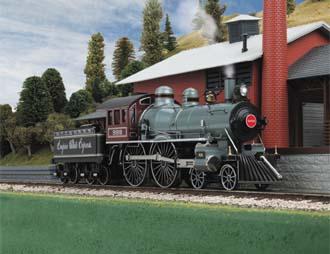
January 12, 2011 - M.T.H.'s O Scale 4-4-0 steam locomotive is the first Premier Line steam locomotive to deliver with the Proto-Sound 3.0 system. Check out the model's details in its New York Central "999" livery in the photos below or click on the video icon to the left to see the engine in action.
In the late 19th century, railroading was the premier high-tech industry, and world’s fairs were the place to compete for bragging rights. So as the 1893 World’s Columbian Exposition approached, the New York Central & Hudson River Railroad prepared to grab the title of fastest vehicle on earth. In great secrecy at the railroad’s West Albany shops, master mechanic William Buchanan directed the construction of a hot-rod 4-4-0 American-type with monstrous drivers more than seven feet in diameter.
Named simply “999,” the engine exuded class. Her hand-polished russian iron boiler was highlighted with shining brass trim and piping; her gleaming cab was fashioned of mahogany and maple; and the name of her train was emblazoned boldly on her tender in two-and-a-half-foot-high gold leaf lettering: “Empire State Express.”
On May 9, 1893, Buchanan turned his creation over to engineer Charlie Hogan to see what she could do. Son of a railroad foreman, Hogan had begun his career with the New York Central at age 14, as a water boy, and would later rise to superintendent of motive power. On that fine May day, he took control of the 999 in Rochester, New York, and opened the throttle for the run to Buffalo. Calculating his time and distance, railroad officials estimated he had reached 102 miles per hour. They decided to try for an official record the next day.
So it was that on May 10, the 999 headed toward Buffalo again, this time with a cargo of railroad officials and newspaper reporters. With fireman Al Elliot madly shoveling coal into the firebox, engineer Hogan opened the throttle all the way. Using stopwatches and counting mileposts, observers on the train determined the 999 had blasted through the Village of Crittenden at 112.5 miles per hour.
Today, most of us understand that technology doesn't ever stand still. A quick review of our products will reveal significant changes over the past decade in our evolving onboard locomotive technology. Despite these improvements, we've always been fully committed to making sure that our products are backward compatible and that each can be operated on conventional layouts while still providing access to many of our most popular operating features.
Since Proto-Sound 2.0's introduction in the Spring of 2000, a few subtle changes have been incorporated into the basic board design including; a different power supply, the ability to operate on AC or DC power, the inclusion of wireless tethers, flash onboard memory, improved microprocessors and improved sound amplifiers.
Regardless of these changes, a year 2000 Proto-Sound 2.0 equipped locomotive runs exactly the same way under the DCS Digital Command Control system as a Proto-Sound 2.0 board built in 2010. You simply put 'em on the track and run 'em.
And so it is with Proto-Sound 3.0. Like the different iterations of the Proto-Sound 2.0 boards built over the past decade, new O Gauge Proto-Sound 3.0 equipped locomotives operate exactly the same way as their 2.0 counterparts. This means they will operate together with 2.0 engines on the same track at the same time when controlled by DCS.
They will operate the same with any compatible conventional AC transformer as 2.0 engines.
They can operate on AC or DC power.
They feature the same conventional control features and include the same command control features.
Most importantly, no new equipment is required to enjoy any feature found inside a Proto-Sound 3.0 equipped locomotive.
Like all evolving technological products, there are a number of new features found inside each Proto-Sound 3.0 equipped locomotive that we believe will continue to ensure that M.T.H. locomotives are the most advanced, most universally compatible and most exciting to operate in all of model railroading.
Chief among these new features is the inclusion of a NMRA Digital Command Control (DCC) receiver. While not a popular command control choice of O Gauge model railroaders, DCC is the dominant command control protocol in other scales, including HO, N, G and 2-Rail O Scale.
By incorporating a DCC receiver into our products, your new Proto-Sound 3.0 equipped locomotive can be operated in command control mode using any DCC controller available today. There are dozens of DCC controllers available from a large number of DCC controller manufacturers. Many of these devices can control all 28 different DCC functions found in every M.T.H. Proto-Sound 3.0 equipped locomotive.
WHERE TO BUY
The Premier Line 4-4-0 steam locomotive can be ordered through any M.T.H. Authorized Retailer.
